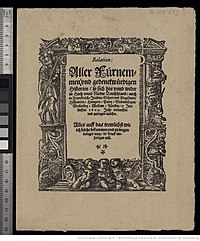| Revision as of 11:31, 9 March 2021 editFight Island (talk | contribs)Extended confirmed users565 edits Importing Wikidata short description: "German publisher" (Shortdesc helper)← Previous edit | Revision as of 20:25, 17 June 2021 edit undoRathfelder (talk | contribs)Extended confirmed users548,588 edits removed Category:German inventors; added Category:17th-century German inventors using HotCatNext edit → | ||
| Line 51: | Line 51: | ||
| ] | ] | ||
| ] | ] | ||
| ] | ] | ||
| ] | ] | ||
Revision as of 20:25, 17 June 2021
German publisher

Johann Carolus (26 March 1575 − 15 August 1634) was a German publisher of the first newspaper, called Relation aller Fürnemmen und gedenckwürdigen Historien (Account of all distinguished and commemorable stories). The Relation is recognised by the World Association of Newspapers, as well as many authors, as the world's first newspaper.
Carolus published the German-language newspaper in Strasbourg, which had the status of a free imperial city in the Holy Roman Empire of the German Nation.
Life
Johann Carolus was born in 1575 in Muhlbach-sur-Munster in the Holy Roman Empire of the German Nation. He was the son of a priest and his wife. He made an apprenticeship as a bookbinder and later worked as a bookseller, a scribe for a newspaper and as a printshop owner. Because of these professions, especially his job as scribe, he held good relationships to postmen and traders, what helped him later to create the Relation aller Fürnemmen und gedenckwürdigen Historien in 1605. Carolus died in 1634 in Strasbourg.
Dating
In 2005, the World Association of Newspapers accepted evidence that the Carolus pamphlet was printed beginning in 1605, not 1609 as previously thought. The Carolus petition discovered in the Strasbourg Municipal Archive during the 1980s may be regarded as the birth certificate of the newspaper:
- "Whereas I have hitherto been in receipt of the weekly news advice and, in recompense for some of the expenses incurred yearly, have informed yourselves every week regarding an annual allowance; Since, however, the copying has been slow and has necessarily taken much time, and since, moreover, I have recently purchased at a high and costly price the former printing workshop of the late Thomas Jobin and placed and installed the same in my house at no little expense, albeit only for the sake of gaining time, and since for several weeks, and now for the twelfth occasion, I have set, printed and published the said advice in my printing workshop, likewise not without much effort, inasmuch as on each occasion I have had to remove the formes from the presses …"
Soon the Relation was followed by other periodicals, such as, the Avisa Relation oder Zeitung.
Definition
If a newspaper is defined by the functional criteria of publicity, seriality, periodicity, and currency or actuality (that is, as a single current-affairs series published regularly at intervals short enough for readers to keep abreast of incoming news) then Relation was the first European newspaper.
Using a single criterion of "format" rather than frequency and function, however, English historian of printing Stanley Morison held that the Relation should be classified as a newsbook, on the grounds that it still employed the format and most of the conventions of a book: it is printed in quarto size and the text is set in a single wide column. By Morison's definition, the world's first newspaper would be the Dutch Courante uyt Italien, Duytslandt, &c. from 1618. By the same definition no German, English, French, or Italian weekly or daily news publications from the first half of the seventeenth century could be considered "newspapers" either. As noted above, the World Association of Newspapers and many authorities have not adopted his definition.
See also
Notes and references
- "WAN - Newspapers: 400 Years Young!". Wan-press.org. Archived from the original on 10 March 2010. Retrieved 21 February 2012.
- Many authors do not make a distinction between a newsbook/pamphlet and a newspaper. See for example: Chappell, W. (1999) A Short History of the Printed Word. Hartley & Marks, Vancouver. Smith, A. (1979) The Newspaper: an international history. Thames and Hudson Ltd, London.
- ^ Johannes Weber, "Straßburg, 1605. The Origins of the Newspaper in Europe", German History 24/2006, pp. 387–412 (409ff.)
- "Strasbourg - Archives de la Ville et de la Communauté urbaine". Archives.strasbourg.fr. Retrieved 21 February 2012.
- Fischer, H.-D. Die Zeitung als Forschungsproblem. In Deutsche Zeitungen des 17. bis 20. Jahrhunderts. Pullach bei München, 1972, p. 13.
- Morison, S. (1980) The Origins of the Newspaper. In Selected Essays on the History of Letter-Forms in Manuscript and Print, (Ed, McKitterick, D.) Cambridge University Press, Cambridge,
Further reading
- Pettegree, Andrew. The Invention of News: How the World Came to Know about Itself (Yale University Press, 2014)
- Weber, Johannes. "Strassburg, 1605: The origins of the newspaper in Europe." German History (2006) 24#3 pp: 387-412.
- "Weber, Johannes: "Unterthenige Supplication Johann Caroli / Buchtruckers". Der Beginn gedruckter politischer Wochenzeitungen im Jahre 1605, Erstveröffentlichung in: Archiv für Geschichte des Buchwesens, Vol. 38 (1992), S. 257-265" (PDF) (in German). Archived from the original (PDF) on 10 June 2007.
External links
- University Heidelberg, Relation aller Fürnemmen und gedenckwürdigen Historien - Facsimile of 1609
- World Association of Newspapers, "Newspapers: 400 Years Young!"
- "400 Jahre Zeitung," exhibition at Gutenberg Museum, Mainz, Germany
- Mitchell Stephens, "History of Newspapers," from Collier's Encyclopedia